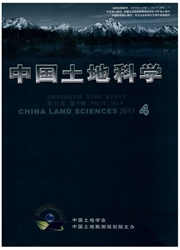

 中文摘要:
中文摘要:
研究目的:分析区域城镇用地配置的影响因素及指标,提出增量城镇用地区域配置的方法。研究方法:文献综述法、最小相对熵方法和三标度AHP方法。研究结果:(1)从土地利用总体规划角度提出了城镇用地现状规模、城镇人口增长预测值、GDP增长预测值、单位面积城镇用地承载城镇人口、单位面积城镇用地GDP5个指标组成的增量城镇用地合理配置指标体系。(2)采用最小相对熵方法求取各影响指标的权重,提出了增量城镇用地区域配置的方法。研究结论:(1)本文的指标体系不仅考虑了不同区域城镇用地的历史以及规划期内的发展趋势,而且体现了土地利用总体规划节约集约用地的要求。(2)采用最小相对熵方法求取各影响指标的权重,在最大程度上保证了所计算的指标权重值的精确性;采用三标度法构建判断矩阵,使得专家打分过程更加简单易行。
 英文摘要:
英文摘要:
The purpose of the paper is to analyze the influential factors and index system of regional allocation of urban and town construction land as well as bring forth the method of regional allocation of newly increased construction land of urban and town. Methods of documentation, minimum relative information entropy method, and 3-scale AHP were employed. The results indicate: (1) from the view of master land use planning, the paper puts forward a reasonable allocation index system of newly increased land of urban and town consisting of 5 indexes: current scale of urban construction land, predictive value of urban population growth, predictive value of GDP growth, urban population per urban construction land, GDP per urban construction land; (2)by using method of minimum relative information entropy, the paper calculates the weight of each influencing index and put forward the method of regional allocation of newly increased construction land of urban and town. It is concluded that, (1)the index system drawn not only considers the history and the development trend of regional urban construction land, but also embodies the requirement of intensive land use in land use planning;(2)calculating the weights of different influencing indexes with the minimum relative information entropy method can ensure the accuracy of calculated weight values to the largest extent; judging matrix with 3-scale method can make the process of expert scoring more simple and practicable.
 同期刊论文项目
同期刊论文项目
 同项目期刊论文
同项目期刊论文
 期刊信息
期刊信息
